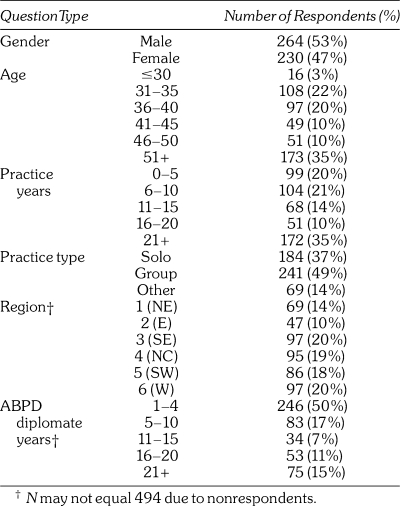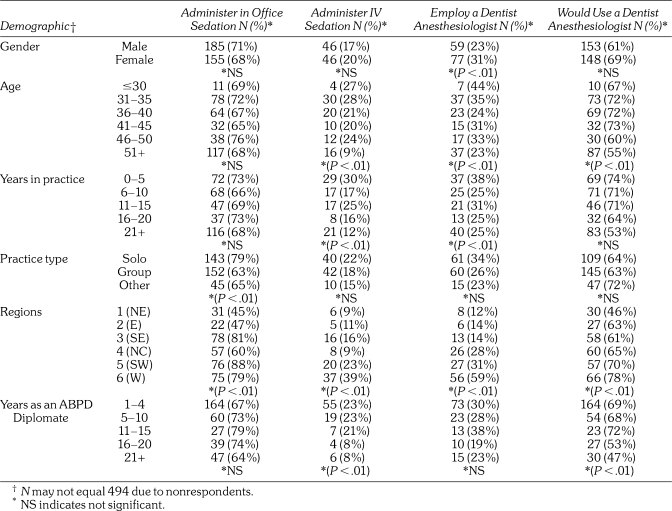Abstract
The purpose of this study is to explore the use of office-based sedation by board-certified pediatric dentists practicing in the United States. Pediatric dentists have traditionally relied upon self-administered sedation techniques to provide office-based sedation. The use of dentist anesthesiologists to provide office-based sedation is an emerging trend. This study examines and compares these two models of office-based sedations. A survey evaluating office-based sedation of diplomates of the American Board of Pediatric Dentistry (ABPD) based on gender, age, years in practice, practice types, regions, and years as a diplomate of the ABPD was completed by 494 active members. The results were summarized using frequencies and percentages. Relationships of dentist age, gender, and number of years in practice with the use of intravenous (IV) sedation was completed using two-way contingency tables and Mantel-Haenszel tests for ordered categorical data. Relationships of office-based sedation use and the type of one's practice were examined using Pearson chi-square tests. Of the 1917 surveys e-mailed, 494 completed the survey for a response rate of 26%. Over 70% of board-certified US pediatric dentists use some form of sedation in their offices. Less than 20% administer IV sedation, 20 to 40% use a dentist anesthesiologist, and 60 to 70% would use dentist anesthesiologists if one were available.
Key Words: Office-based, Dentist-anesthesiologist, Pediatric dentist
Office-based sedation and anesthesia is a critical component of the modern pediatric dental practice. This is especially true for the management of special populations that include patients with cognitive impairments, developmental delay, precooperative age, and other conditions that limit the effectiveness of behavior management techniques. Some pediatric dentists provide minimal or moderate sedation while simultaneously performing dentistry. Although this practice has been a cornerstone of pediatric dental practice for generations, there are limitations to the depth and effectiveness of sedation that can be provided using this technique.1,2,3
The use of dentist anesthesiologists appears to be an emerging trend in pediatric dental practice.4 Dentist anesthesiologists provide a broader range of anesthesia services, ranging from moderate sedation to general anesthesia. The addition of a dentist anesthesiologist to the pediatric dental office team provides a way to expand depth, scope, and effectiveness of office-based sedation and anesthesia services.4 However, the number of dentist anesthesiologists practicing in the United States is relatively small, and certain areas of the country have limited access to their services.5
This study examines the office-based sedation and anesthesia practices of board-certified pediatric dentists in the United States. A broad range of data was collected that would allow a comparison of the use of self-administered sedation services by pediatric dentists with the use of dentist anesthesiologists for office-based sedation and anesthesia services.
METHODS
Following approval by the Indiana University Institutional Review Board, all active board-certified pediatric dentists who are members of the American Academy of Pediatric Dentistry (AAPD) received an e-mail notification requesting their participation in an online SurveyMonkey questionnaire. According to the AAPD membership list, there were approximately 4,300 registered pediatric dentists, 2,586 of whom are diplomates of the American Board of Pediatric Dentistry (ABPD). According to a 1980 survey by the Association of Pedodontic Diplomates, future studies of pedodontists (pediatric dentists) can best be determined by polling ABPD Diplomates who are also members of the AAPD.
The survey items are listed in the Appendix. Diplomates of the ABPD received a request via e-mail to participate in an anonymous survey. A second e-mail request was sent 3 weeks later to nonrespondents. The anonymous survey was returned for data collection and statistical analysis. Survey items focused on gender, age, years in practice, region of practitioners, number of years as a diplomate of the ABPD, use of in-office sedation, use of intravenous (IV) sedation, use of a dentist anesthesiologist, and comment on the use of a dentist anesthesiologist.
All survey responses were summarized using frequencies and percentages. Relationships of dentist age, number of years in practice, and number of years as a diplomate of the ABPD with the use of sedation, IV sedation, use of a dentist anesthesiologist, and use of a dentist anesthesiologist if services were available were examined using two-way contingency tables and Mantel-Haenszel tests for ordered categorical data. Relationships of region, gender, type of practice, use of sedation, use of IV sedation, use of a dentist anesthesiologist, and use of a dentist anesthesiologist if their services were available were examined using Pearson chi-square tests.
RESULTS
The survey was sent to all board-certified pediatric dentists who made their e-mail address available on the membership roster provided by the AAPD (N = 2586). Six hundred fifty-nine requests were returned as “undeliverable.” A final count of 494 of the 1927 practitioners surveyed (26%) completed and returned the survey. Table 1 shows the number of ABPD members that responded to the survey based on gender, age, years in practice, practice type, region where they practice, and years as a diplomate of the ABPD.
Table 1.
Total Number of Respondents
Of respondents, 53% (N = 264) were male and 47% (N = 230) were female. Age distribution of respondents ranged from less than 30 years of age (N = 16, 3%) to 51+ years (N = 173, 35%). Years in practice for respondents ranged from 0–5 years (N = 99, 20%) to 21+ years (N = 172, 35%).
Of respondents, 37% (N = 184) reported being in solo practice, 49% (N = 241) being in a group practice and 14% (N = 69) being in another practice type. Respondents reported practicing in a comprehensive distribution of regions in the United States. The lowest region of respondents reported practicing in the east region (N = 47, 10%), and the highest number reported practicing in the west region (N = 97, 20%).
The responses displayed different patterns when the number of years of ABPD diplomate status was compared to age and years in practice. Of the respondents, 50% (N = 246) had been diplomates for 5 years or less. However, the largest age group among respondents was 51+ years (N = 173, 35%) followed by the 31–35 year olds (N = 108, 22%) and the 36–40 year olds (N = 97, 20%). With regard to years in practice, 35% (N = 172) had been in practice 21 or more years, followed by the 0–5 years in practice group (N = 99, 20%) and the 6–10 years in practice group (N = 104, 21%). This suggests a bimodal distribution of age and years in practice among the diplomats who completed this survey, with early career and late career pediatric dentists making up the largest groups.
Table 2 shows the responses of ABPD members to administering sedation in office, administering IV sedation in office, using a dentist anesthesiologist, and those who would use a dentist anesthesiologist if one were available based on gender, age, years in practice, practice type, region where they practice, and years as a diplomate of the ABPD. Analysis of data reported in Table 2 is presented in the following sections.
Table 2.
Responses Regarding Use of Sedation and Dentist Anesthesiologists by Demographic
Gender
There was a statistical difference (P < .01) in using a dentist anesthesiologist with respect to gender (Figure 1). More female respondents (N = 77, 39%), as compared to male respondents (N = 59, 23%), reported they used a dentist anesthesiologist. There was no significant difference between the male and female respondents with regard to administering sedation in office, administering IV sedation in office, and using a dentist anesthesiologist if one were available.
Figure 1.
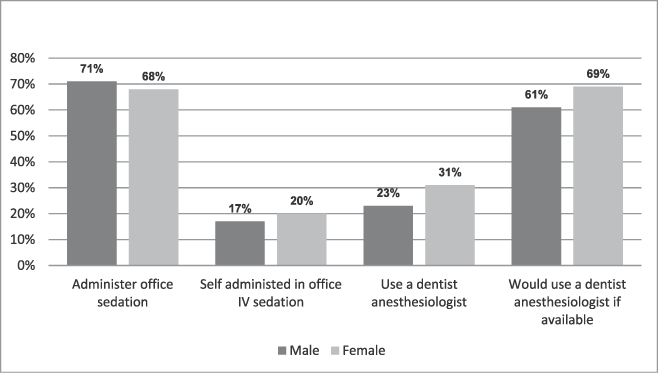
Gender.
Age
There was a statistically significant difference in administering IV sedation (P < .01), using a dentist anesthesiologist (P < .01) and using a dentist anesthesiologist if one were available (P < .01) among the age of the respondents (Figure 2). The 51+ year old respondents were less likely, compared to all other age group respondents, to administer IV sedation and use a dentist anesthesiologist, and would less likely use a dentist anesthesiologist if one were available. There was no statistically significant difference among age of respondents in administering some form of sedation in office.
Figure 2.
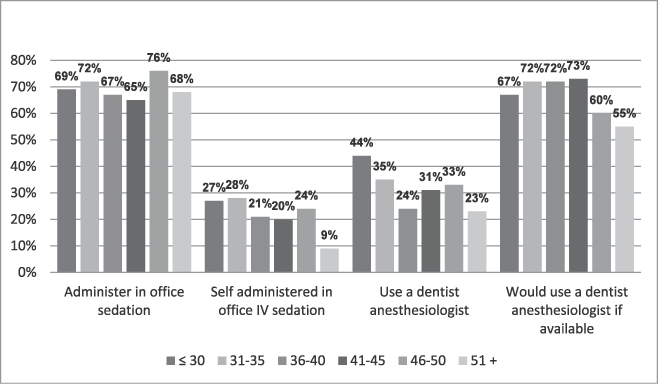
Age.
Years in Practice
There was a statistically significant difference in administering IV sedation in office (P < .01) and using a dentist anesthesiologist (P < .01) among the respondents (Figure 3). Respondents who have been in practice for 21+ years were least likely to use IV sedation in their office (12%) and among the least likely to use a dentist anesthesiologist (25%). There was no statistically significant difference between years in practice and administering some form of sedation in office and using a dentist anesthesiologist if one were available.
Figure 3.
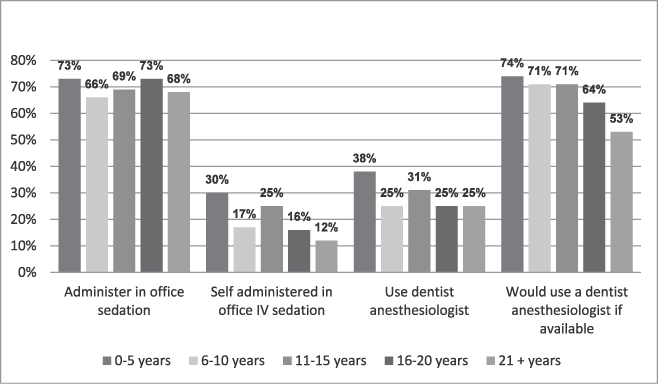
Years in practice.
Practice Type
There was a statistically significant difference (P < .01) among practice types and administering some form of in-office sedation (Figure 4). The group type of practice was the least likely (63%) to administer some form of in-office sedation. There was no statistically significant difference in practice type when administering IV sedation, using a dentist anesthesiologist, and using a dentist anesthesiologist if their services were available.
Figure 4.
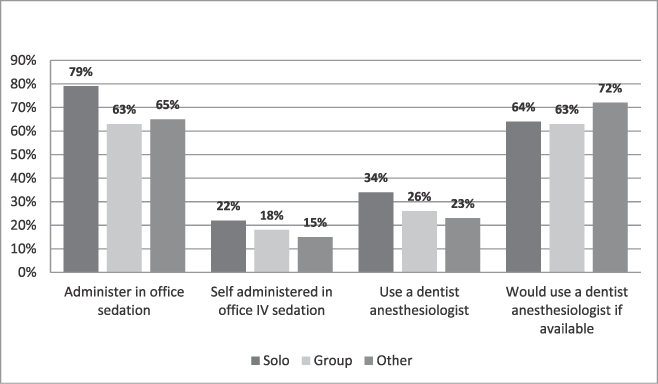
Practice types.
Regions
Most respondents (20%) were localized in AAPD regions 3 (Southeast) and 6 (West), respectively (Table 1). As seen in Table 2, there was a statistically significant difference among the regional respondents to administering some form of in-office sedation (P < .01), administering IV sedation (P < .01), employing a dentist anesthesiologist (P < .01), and using dentist anesthesiologists if their services were available (P < .01). From a regional perspective, district 5 (Southwest) had the highest percentage of respondents (88%) reporting that they administered some form of in-office sedation; district 6 (West) had the highest percentage of respondents reporting that they administered in-office IV sedation (39%), employed the services of a dentist anesthesiologist (59%), and would use a dentist anesthesiologist (78%) if one were available (Figure 5). It is interesting to note that the desire to use a dentist anesthesiologist, if available, is consistently higher than the number of pediatric dentists providing their own anesthesia in every region of the country.
Figure 5.
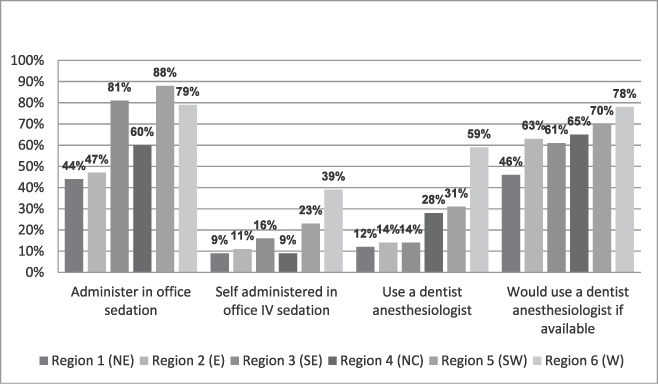
Regions.
Years as a Diplomate of the ABPD
There was a statistically significant difference among respondents with respect to administering IV sedation (P <.01) and using a dentist anesthesiologist if their services were available (P < .01). Respondents who have been board certified for 16–20 and 21+ years were the least to administer in-office IV sedation (8%and 8% respectively) and would use the services of a dentist anesthesiologist if one were available (47% and 53%, respectively). There was no statistically significant difference among ABPD respondents in administering some form of in-office sedation and employing a dentist anesthesiologist (Figure 6).
Figure 6.
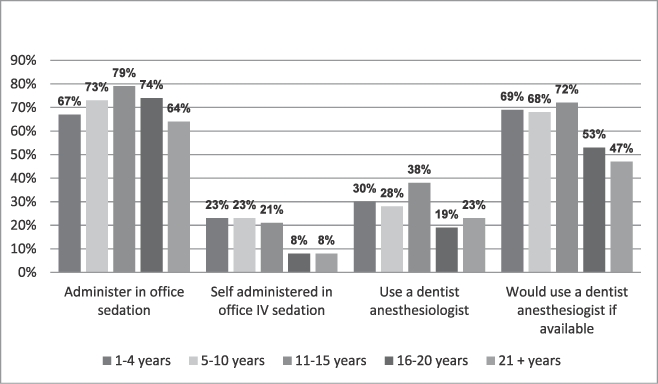
Years as an ABPD diplomate.
DISCUSSION
One limitation of this study was the relatively low response rate. Of the 1927 board-certified pediatric dentists with valid e-mail addresses at the start of this study, 494 (26%) responded to the survey. A response rate of 26%, although considered acceptable, only represents approximately 19% of the 2586 ABPD members provided by the AAPD.
The results of this study indicated that female ABPD members were more likely to employ a dentist anesthesiologist than male members; this result has not been previously reported in the literature.
The age of the respondents did not show any statistically significant difference in administering some form of in-office sedation. The results of this study demonstrated that all respondents administered some form of in-office sedation, which correlates with the study by Boynes et al6 that evaluated the practice characteristics among dental anesthesia providers in the United States. They concluded that the enteral sedation technique was the most frequently used sedation/anesthesia technique used by pediatric dentists (63%).
Overall, this study showed that the longer the respondents have been in practice, practiced in a group setting, and have been ABPD members, the least likely they are to use IV sedation, use a dentist anesthesiologist, and use dentist anesthesiologists if their services were available. There are many factors that could lead to these findings. The newest ABPD members could have more training in IV sedation and are therefore are more comfortable in using IV sedation. These results have not been previously reported in the literature.
From a regional perspective, this study demonstrated that there was a statistically significant difference in the clinical practice and administration of IV sedation by ABPD respondents. One of the reasons could be the different sedation/anesthesia laws associated with each state. This study did not obtain the reason for the above conclusion, and no results have been reported previously in the literature to prove otherwise.
CONCLUSION
The objective of this questionnaire-based study was to explore the use of office-based sedation by board-certified pediatric dentists practicing in the United States. Additionally, the intention of this study was to document information related to the use of IV sedation and the use of dentist anesthesiologists for deep sedation and general anesthesia. The sample of diplomates responding to this survey tended to be either new or recent graduates, or established pediatric dentists with more than 20 years of experience.
Of the 1927 surveys e-mailed, 494 completed the survey for a response rate of 26%. Over 70% of board-certified US pediatric dentists use some form of sedation in their offices. Less than 20% administer IV sedation, 20 to 40% use a dentist anesthesiologist, and 60 to 70% would use a dentist anesthesiologist if one were available.
Female ABPD members are more likely to use a dentist anesthesiologist, and the newer ABPD members are more likely to use IV sedation, use a dentist anesthesiologist, and use a dentist anesthesiologist if one were available. In every region of the country, the desire to use a dentist anesthesiologist, if available, is consistently higher than the number of pediatric dentists providing their own anesthesia.
APPENDIX
Survey Items
Gender
Male
Female
Age
≤ 30
31–35
36–40
41–45
46–50
51+
Number of years in practice
0–5
6–10
11–15
16–20
20+
Type of practice
Solo
Group
Other
Region of practice
Region 1 (NE)
Region 2 (E)
Region 3 (SE)
Region 4 (NC)
Region 5 (SW)
Region 6 (W)
Years as a Diplomate of the ABPD
1–4
5–10
11–15
16–20
20+
Do you administer sedation in your office?
Yes
No
Do you use IV sedation in your office?
Yes
No
Do you use the services of a dentist anesthesiologist?
Yes
No
Would you use the services of a dentist anesthesiologist, if available?
Yes
No
REFERENCES
- 1.American Academy of Pediatric Dentistry. Guideline on behavior guidance for the pediatric dental patient. Reference Manual. 2010–2011;32(6):147–155. [Google Scholar]
- 2.American Academy of Pediatric Dentistry. Guideline on use of anesthesia personnel in the administration of office-based deep sedation/general anesthesia to the pediatric dental patient. Reference Manual. 2010–2011;32(6):184–186. [Google Scholar]
- 3.American Academy of Pediatric Dentistry. Guideline on management of dental patients with special health care needs. Reference Manual. 2010–2011;32(6):132–136. [Google Scholar]
- 4.American Society of Dentist Anesthesiologists. The necessity for advanced anesthesia services for dental care. Available at: http://www.asdahq.org/DentistAnesthesiologist/AboutASDADA.aspx. October 14, 2010. [Google Scholar]
- 5.Sheller B. Challenges of managing child behavior in the 21st century dental setting. Pediatr Dent. 2004;26:111–113. [PubMed] [Google Scholar]
- 6.Boynes SG, Moore PA, Tan PM, Zovko J. Practice characteristics among dental anesthesia providers in the United States. Anesth Prog. 2010;57:52–58. doi: 10.2344/0003-3006-57.2.52. [DOI] [PMC free article] [PubMed] [Google Scholar]



